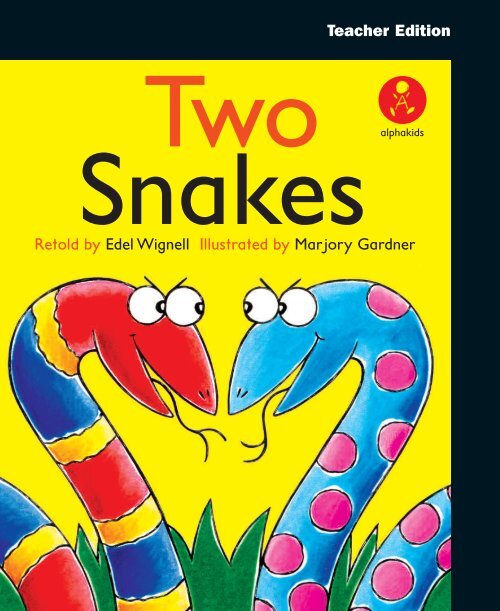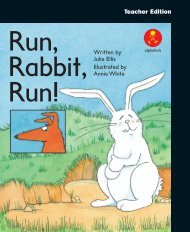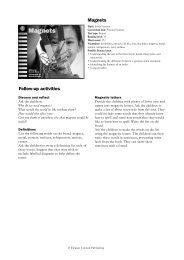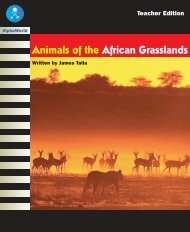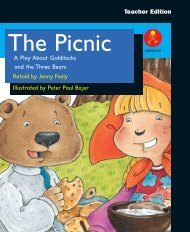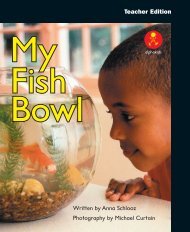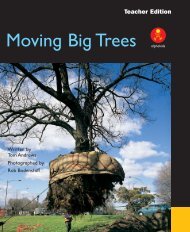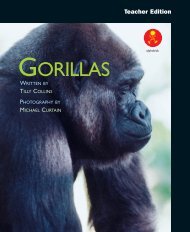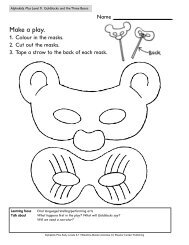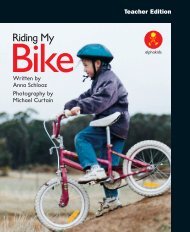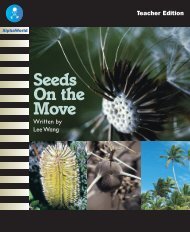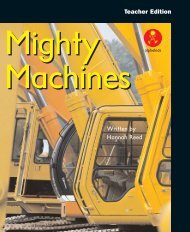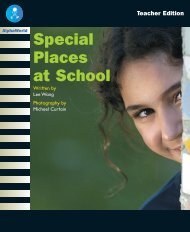Two Snakes
Two Snakes
Two Snakes
You also want an ePaper? Increase the reach of your titles
YUMPU automatically turns print PDFs into web optimized ePapers that Google loves.
Teacher Edition<br />
<strong>Two</strong><br />
<strong>Snakes</strong><br />
alphakids<br />
Retold by Edel Wignell Illustrated by Marjory Gardner
Published edition<br />
© Eleanor Curtain<br />
Publishing 2004<br />
First published 2004<br />
Apart from any fair dealing for<br />
the purposes of study, research,<br />
criticism or review, as<br />
permitted under the Copyright<br />
Act of Australia, no part of this<br />
book may be reproduced by<br />
any process, or transmitted in<br />
any form, without permission<br />
of the copyright owner. Where<br />
copies of part or the whole of<br />
this book are made under Part<br />
VB of the Copyright Act, the<br />
law requires that records of<br />
such copying be kept and the<br />
copyright owner is entitled to<br />
claim payment.<br />
Developed by<br />
Eleanor Curtain Publishing<br />
Text: Kerrie Shanahan<br />
Consultant: Susan Hill<br />
Designed by<br />
Alexander Stitt<br />
Production by<br />
Publishing Solutions<br />
Printed in China<br />
ISBN 0 7253 3401 0<br />
1 2 3 4 5 6 7 8 9<br />
04 05 06<br />
<br />
How to use this book<br />
Before reading: Talkthrough<br />
Talk through the book with the children. Encourage<br />
them to predict the text from the cover and the<br />
pictures, and to think about the information they<br />
provide. Direct the children’s attention to aspects of<br />
the text that may challenge them. Support the children<br />
to deal with these challenges by asking the<br />
Talkthrough questions on each page.<br />
During reading: Observe and support<br />
Observe the children as they read. Encourage them to<br />
monitor their own reading as they comprehend the<br />
text. As needed, support the children by helping them<br />
to discover and use reading strategies and cues to solve<br />
problems and respond to reading challenges that arise<br />
in the text. Interruptions to the children’s reading<br />
should be minimal and focused on specified learning<br />
needs.<br />
After reading: Comprehension, returning to<br />
the text, responding and writing links<br />
To further develop children’s understanding of the<br />
text, select from activities found on page 16 and the<br />
inside back cover. These whole text, sentence and word<br />
level activities reinforce the teaching focus of this<br />
book. Assessment ideas are provided to assist with<br />
planning for further teaching.<br />
Text highlights<br />
• The use of direct speech.<br />
• Humour is used in both the text and the<br />
illustrations.<br />
Vocabulary<br />
egg, first, hissed, hungry, lunch, mine, second,<br />
slithered, snakes, swallowed, tail, two, yum
Setting the context<br />
You may like to talk about how snakes are<br />
portrayed in stories.<br />
Have you ever read any stories with snakes<br />
in them What are the snakes like in these<br />
stories<br />
Introducing the book<br />
The book we are going to read is a retelling<br />
of a story about two snakes and an egg. It is<br />
told in a funny way, and there is a moral to<br />
the story. Who knows what a moral is<br />
Front cover<br />
This book is called <strong>Two</strong> <strong>Snakes</strong>. Do you<br />
think it is a fiction or non-fiction book Why<br />
do you think this<br />
Title page<br />
This story has been retold by Edel Wignell.<br />
What does retold mean Why might<br />
someone want to retell a story
<strong>Two</strong> <strong>Snakes</strong> Pages 2–3<br />
<br />
Talkthrough<br />
These snakes look very happy. What are they doing<br />
How would you describe the way the snakes are moving<br />
What have they found<br />
Observe and support<br />
Do the children use all of the information on the page<br />
to solve problems when reading<br />
How did you know that word was ‘egg’<br />
If a child is having difficulty with a word, ask the<br />
following questions:<br />
What can you see in the picture What letter does the word<br />
start with What sound does this letter make<br />
2
<strong>Two</strong> <strong>Snakes</strong> Pages 4–5<br />
<br />
Talkthrough<br />
Look at the snakes’ faces. How is the striped snake feeling<br />
How is the spotted snake feeling How can you tell this<br />
Observe and support<br />
Do the children understand the text at a literal level<br />
Do they read to gain meaning<br />
What were the two snakes looking for What did they find<br />
What did they say when they found the egg<br />
4
<strong>Two</strong> <strong>Snakes</strong> Pages 6–7<br />
<br />
Talkthrough<br />
These two snakes want to eat the egg. Have you ever wanted<br />
exactly the same thing as someone else What happened<br />
What might happen next in this story<br />
Observe and support<br />
Do the children monitor their own reading Do they<br />
recognise when they have made a mistake<br />
I noticed that when you made a mistake you re-read the<br />
sentence and then tried to work out what the right word was.<br />
How did you know you had made a mistake What things did<br />
you do to work out the right word<br />
6
<strong>Two</strong> <strong>Snakes</strong> Pages 8–9<br />
<br />
Talkthrough<br />
Now the snakes are arguing. What do you think the snakes are<br />
about to do Why are they going to do this<br />
What would you do if you were one of the snakes<br />
Observe and support<br />
Do the children read with expression<br />
How are the snakes feeling How might they say, ‘It’s mine!’<br />
What does an exclamation mark tell us about how we read a<br />
sentence<br />
8
<strong>Two</strong> <strong>Snakes</strong> Pages 10–11<br />
<br />
Talkthrough<br />
The snakes are slithering around the egg. Which one will end up<br />
getting the egg Which one should have the egg Why<br />
Observe and support<br />
Can the children use a range of strategies to work out<br />
new vocabulary, such as ‘slithered’ or ‘hissed’<br />
How did you know that word was ‘slithered’<br />
If a child is having difficulty with a word, ask the<br />
following questions.<br />
What are the snakes doing What sort of word would make<br />
sense here What letters does the word start with What sound<br />
do these letters make What word would fit here<br />
10
<strong>Two</strong> <strong>Snakes</strong> Pages 12–13<br />
<br />
Talkthrough<br />
The snakes have grabbed each other’s tails. Is this a good way<br />
to solve the problem What could they do instead What will<br />
happen next<br />
Observe and support<br />
Can the children use their understanding of lettersound<br />
relationships to support their reading<br />
How did you know that word said ‘grabbed’<br />
If a child is having difficulty with a word such as<br />
‘grabbed’, ask the following questions.<br />
What letters does the word start with What sound do these<br />
letters make when they are together What are the snakes<br />
doing What word would fit here<br />
12
<strong>Two</strong> <strong>Snakes</strong> Pages 14–15<br />
<br />
Talkthrough<br />
What is happening to the snakes in this picture<br />
Observe and support<br />
Can the children interpret the text<br />
What did the snakes want to eat Did they eat the egg Why<br />
not What could the snakes have done instead<br />
14
<strong>Two</strong> <strong>Snakes</strong> Page 16<br />
Talkthrough<br />
What does this picture tell us<br />
Did you expect the story to end this way<br />
16<br />
After reading<br />
Being a meaning maker<br />
Encourage the children to support their responses<br />
with evidence from the book as they discuss these<br />
comprehension questions.<br />
What did the snakes want to eat<br />
What did they end up eating<br />
Why did they eat each other<br />
What did the author want people to learn from this story
Being a code breaker<br />
Explore the following language features:<br />
• High-frequency words: went, to for,<br />
the, saw, an, he, said, my, they, were,<br />
no, was.<br />
• Word that rhyme with ‘snake’: bake,<br />
cake, fake, lake, make, quake, rake,<br />
sake, shake, stake, take, wake.<br />
Being a text user<br />
Refer to the text when discussing these<br />
questions.<br />
What kind of story is this How do you know<br />
You might like to spend some time<br />
talking about the features of tall tales.<br />
Tall tales usually consist of exaggerated<br />
characters or unbelievable plots. These<br />
stories often have a moral, such as ‘Greed<br />
will lead to a bad end’ or ‘Be happy with<br />
what you have’.<br />
Being a text critic<br />
Could this story really happen Why or why<br />
not<br />
What have the author and illustrator done to<br />
make this book funny<br />
Would it have been as funny if the pictures<br />
were photographs<br />
Would the story have worked if the two snakes<br />
had let go of each other before they<br />
disappeared completely<br />
Responding to text<br />
Provide the children with black<br />
paper, coloured cellophane, kebab<br />
sticks and tape. Ask them to work in<br />
cooperative groups to make stick puppets<br />
to retell the text. The shadow puppet play<br />
could be shown using an overhead<br />
projector as the light source and a large<br />
piece of paper for the screen.<br />
Have the children work in small<br />
groups to make a poster that<br />
depicts the moral of the story; for<br />
example, ‘Greed will lead to a bad end’.<br />
Ask the children to list all the<br />
words they know that rhyme with<br />
‘snake’.<br />
Writing<br />
Encourage the children to innovate on<br />
the text to write another tall tale. For<br />
example, what if two elephants saw the<br />
same peanut and both wanted to eat it<br />
The children could work in pairs to write<br />
their own retelling of the story. Their<br />
work could be illustrated and then<br />
collated to make a class book.<br />
Assessment<br />
Can the children:<br />
• explain why the book is a ‘tall tale’<br />
• interpret the text to explain why greed can be a problem<br />
whole text activity sentence activity word activity
alphakids<br />
<strong>Two</strong><br />
<strong>Snakes</strong><br />
Retold by Edel Wignell Illustrated by Marjory Gardner<br />
Teacher<br />
Edition<br />
Other<br />
books<br />
at this<br />
level<br />
Making<br />
Making Spaghetti<br />
Written by Jack Hastings<br />
Spaghetti<br />
Photography by Michael Curtain<br />
alphakids<br />
Topic: Greed<br />
Curriculum link: English<br />
Text type: Narrative<br />
Reading level: 9<br />
Word count: 134<br />
High-frequency words: went, to for, the, saw, an,<br />
he, said, my, they, were, no, was<br />
Vocabulary: egg, first, hissed, hungry, lunch, mine,<br />
second, slithered, snakes, swallowed, tail, two, yum<br />
Possible literacy focus<br />
• Exploring the concept of tall tales in writing.<br />
• Interpreting the text to explore the consequences<br />
of being greedy.<br />
Campingalphakids<br />
Written by Sarah O’Neil<br />
Photography by<br />
Michael Curtain<br />
The<br />
Fox<br />
and the<br />
Snail<br />
alphakids<br />
Goldilocks and the<br />
Three<br />
Baby Bear<br />
Goes for Bears a Walk<br />
Retold by Jenny Feely<br />
Illustrated by Peter Paul Bajer<br />
Whales<br />
Written by Hannah Reed<br />
Illustrated by Liz Cogley<br />
alphakids<br />
alphakids<br />
Summary<br />
This book is a humorous retelling of a story about<br />
two snakes fighting over an egg they both want to<br />
eat.<br />
Retold by Edel Wignell<br />
Illustrated by Alex Stitt<br />
ISBN 0- 7253- 3401- 0<br />
9 780725 334017<br />
alphakids


